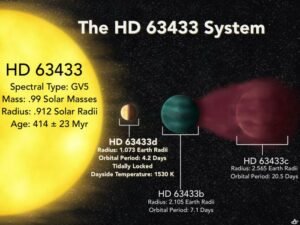Astronomers have discovered an Earth-sized planet orbiting a star similar to the sun, only 73 light years away. Previous studies using the Transiting Exoplanet Survey Satellite (TESS) had spotted two larger planets around the star in 2020; the new planet was discovered during follow-up observations designed to confirm the earlier findings.
Astronomers have previously found Earth-sized planets around distant stars, but nearly all of those have been found orbiting smaller, cooler red dwarf stars instead of G-type main sequence stars like our sun. The relatively close nature of the new find also opens up opportunities to study the planet more closely, with hopes that it can offer previously unavailable insights.
“It’s a useful planet because it may be like an early Earth,” explained Melinda Soares-Furtado, a NASA Hubble Fellow at the University of Wisconsin–Madison and the lead author of the paper describing the unique discovery.
Earth-sized planet Similar and Different from Our Earth
In their study, published in the Astronomical Journal, Soares-Furtao, her colleague Benjamin Capistrant, and an international team of researchers explain how they made the unexpected discovery and how the find could offer up clues to Earth’s formation.
For example, the new planet, dubbed HD 63433d, is similar in size to Earth. However, the planet is much closer to its host star than Earth, orbiting star HD63433 every 4.2 days. According to the researchers, that makes it an unlikely place to look for life as we know it.
“Even though it’s really close-orbiting, we can use follow-up data to search for evidence of outgassing and atmospheric loss that could be important constraints on how terrestrial worlds evolve,” Soares-Furtado says. “But that’s where the similarities (with Earth) end — and end dramatically.”


Another key difference is that the planet is tidally locked, meaning one side of it is always facing its host star and the other remains in permanent darkness. As a result, the side facing the star can reach a scorching 2,300 degrees Fahrenheit while the cold side remains below freezing.
Its host star, HD 63433, is also only about 400 million years old, making it 90 percent younger than the sun. The researchers also point out that its host star is bright enough that is could be spotted without powerful telescopes.
“On a dark night in Madison, you could see [HD 63433] through a good pair of binoculars,” said Soares-Furtado.
Discovery Could Open Up Hunt for Life-Supporting Exoplanets
While sharing similarities and differences with Earth, the new planet is still considered an exceptional find. That’s because G-type Main Sequence stars are usually too bright for Earth’s telescopes to spot planets this small, but instead simply blot out their meager light signal.
To date, astronomers have yet to find an Earth-sized planet around a sun-like star that also resides in the star’s habitable zone where potentially life-supporting liquid water can exist on its surface. Still, the discovery represents a step in that direction.
Moving forward, the team says that finding a planet so similar in size to Earth around a star so similar to the sun can open up a number of tantalizing possibilities for further studies. These opportunities are further enhanced by the fact that the star is so close, cosmically speaking and that it can be seen from both the Northern and Southern hemispheres, where different telescopes and instruments can undertake separate studies.
“This is our solar backyard, and that’s kind of exciting,” Soares-Furtado says.
Ultimately, the researchers say that this find is simply a first step and that many untold secrets may still lie hidden in the newly found planet and its nearby stars, including how Earth-sized planets that may host extraterrestrial life are formed.
“What sort of information can a star this close, with such a crowded system around it, give away?” she adds. “How will it help us as we move on to look for planets among the maybe 100 other similar stars in this young group it’s part of?”
Christopher Plain is a Science Fiction and Fantasy novelist and Head Science Writer at The Debrief. Follow and connect with him on X, learn about his books at plainfiction.com, or email him directly at christopher@thedebrief.org.

